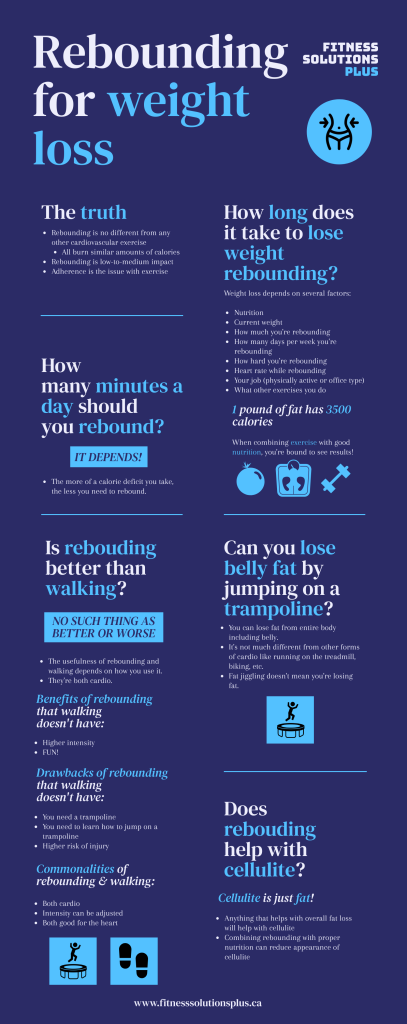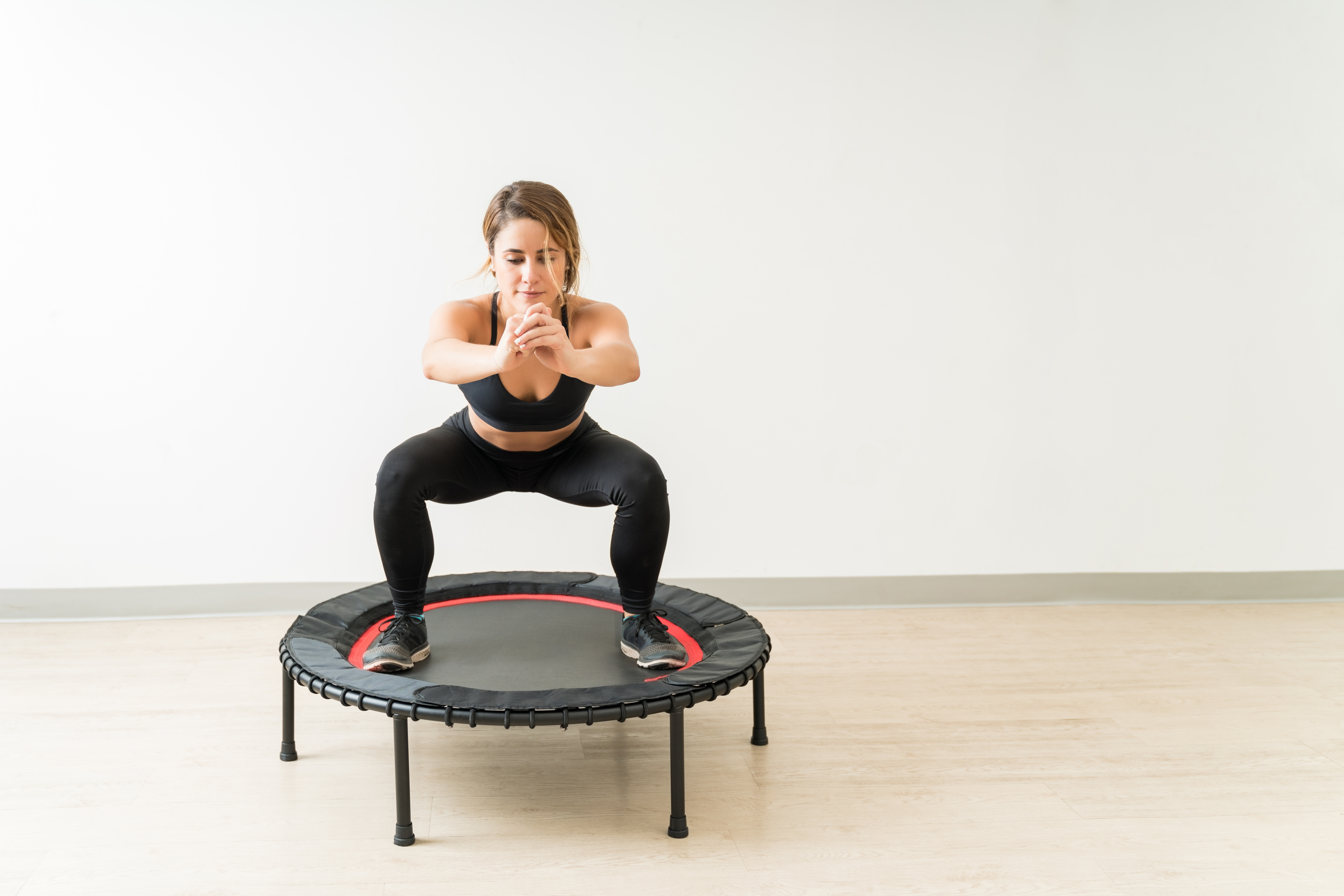Looking to shed extra pounds? Discover the benefits of rebounding for weight loss. Burn calories, tone muscles, and improve overall fitness. Read more!
If you’re looking for an effective and enjoyable way to shed those extra pounds, look no further than rebounding. Rebounding refers to the act of bouncing on a mini-trampoline, and while it may sound simple, the benefits it offers for weight loss are anything but. In fact, rebounding has been found to be an efficient cardiovascular exercise that not only burns calories but also helps tone muscles and improve overall fitness. But how long should you rebound to maximize weight loss? Read on to find out.
How Rebounding Can Help You Lose Weight
Rebounding, a form of exercise that involves jumping on a mini trampoline, has gained popularity in recent years for its numerous health benefits. Not only is it a fun and enjoyable way to stay active, but rebounding can also be an effective tool for weight loss. In this article, we will explore the various ways rebounding can help you shed those extra pounds and achieve your weight loss goals.

Increase in Caloric Expenditure
One of the primary advantages of rebounding for weight loss is its ability to increase caloric expenditure. When you engage in rebounding, you perform a series of jumps and bounces that require significant physical effort. This high-intensity cardiovascular workout brings your heart rate up, causing your body to burn calories at an accelerated rate.
Effective Way to Burn Calories
Compared to other forms of exercise, rebounding has been found to be highly effective in burning calories. Research suggests that a 30-minute rebounding session can burn up to 160-240 calories, depending on factors such as weight and intensity of exercise. This calorie-burning potential makes rebounding a valuable addition to any weight loss regimen.
Comparison to Other Forms of Exercise
In a study comparing various forms of exercise, rebounding emerged as a standout in terms of calorie burn. The research found that rebounding burned more calories per minute than jogging, cycling, or even dancing. This difference is due to the increased gravitational force experienced during rebounding, which intensifies the workout and leads to greater calorie expenditure.
Calorie Burn Potential
The calorie burn potential of rebounding is not limited to the duration of the exercise itself. Studies have shown that rebounding can elevate your metabolic rate for an extended period post-workout. This post-exercise calorie burn, also known as excess post-exercise oxygen consumption (EPOC), means that even after you finish rebounding, your body continues to burn calories at a higher rate as it recovers from the exercise.
Improved Metabolism
Aside from increasing caloric expenditure, rebounding also has a positive impact on your metabolism, which can contribute to weight loss in the long term.
Effect of Rebounding on Metabolic Rate
Research has indicated that rebounding can significantly increase your metabolic rate. By engaging in this type of exercise, you stimulate your muscles and cardiovascular system, leading to a temporary rise in metabolic activity. This heightened metabolism allows your body to burn calories more efficiently, ultimately supporting your weight loss journey.
Increased Caloric Burn throughout the Day
Another advantage of rebounding for weight loss is the prolonged effect it has on your metabolism. Studies have shown that participating in rebounding sessions can elevate your metabolic rate for several hours after exercise. This post-workout metabolic boost translates into additional calorie burn throughout the day, even when you are at rest.
Long-Term Impact on Weight Loss
Regular rebounding not only enhances your metabolic rate in the immediate aftermath of exercise but also contributes to long-term changes. By keeping your metabolism elevated consistently, rebounding can help you achieve and maintain a healthy weight. Furthermore, improved metabolism supports fat loss and prevents weight regain, making rebounding a valuable tool in your weight loss arsenal.

Enhanced Lymphatic System Function
The lymphatic system, responsible for removing toxins and waste from your body, plays a crucial role in weight loss. Rebounding has been found to have a positive impact on lymphatic system function, making it an effective aid in shedding unwanted pounds.
Importance of Lymphatic System for Weight Loss
The lymphatic system acts as a vital part of the body’s immune system and assists in waste removal. When the lymphatic system is not functioning optimally, toxins and waste can accumulate in the body, hindering weight loss efforts. Therefore, supporting the health and efficiency of the lymphatic system is essential for successful weight management.
Efficient Removal of Toxins
Jumping on a mini trampoline stimulates the lymphatic system, promoting lymph flow and improving its ability to cleanse the body of toxins. The rhythmic bouncing motion during rebounding facilitates the contraction and relaxation of lymphatic vessels, effectively removing waste and aiding detoxification. By effectively eliminating harmful substances from your body, rebounding supports optimal weight loss outcomes.
Reduced Water Retention
Water retention can be a frustrating obstacle when trying to lose weight. Excess fluid buildup can lead to bloating and make you feel heavier than you actually are. Fortunately, rebounding can help address this issue by stimulating the lymphatic system to remove excess fluid. By reducing water retention, rebounding can help you achieve a leaner and more toned physique.
Muscle Toning and Increased Strength
While weight loss often focuses on reducing body fat, it is also essential to maintain and build muscle mass. Rebounding provides an effective means of achieving muscle toning and increased strength alongside your weight loss goals.
Engagement of Multiple Muscle Groups
Rebounding engages a wide range of muscle groups throughout the body. From the calves and quadriceps to the core and upper body, the repetitive jumping and bouncing motion requires coordination and activation of various muscles. This comprehensive muscle engagement leads to improved muscle tone and conditioning, contributing to a leaner and more sculpted physique.
Improved Muscle Definition
By incorporating rebounding into your fitness routine, you can enhance muscle definition and achieve a more sculpted appearance. Regular rebounding sessions help tone muscles and reduce overall body fat, resulting in greater muscle visibility. This muscle definition not only improves your physical aesthetics but also increases your overall strength and functional abilities.
Positive Impact on Resting Metabolic Rate
Building muscle through rebounding offers a long-term advantage for weight loss. The more muscle mass you have, the higher your resting metabolic rate (RMR) will be. This means that even at rest, your body will burn more calories, improving overall weight management. Rebounding provides a challenging, yet low-impact way to increase strength, build muscle, and boost your resting metabolic rate.

Stress Reduction
When it comes to weight loss, managing stress levels is often an overlooked but crucial aspect. Rebounding serves as a stress-relieving activity, helping you maintain a balanced mindset and supporting your weight loss efforts.
Physical Activity and its Effects on Stress Levels
Engaging in physical activity has long been recognized as an effective way to reduce stress and improve mental well-being. Regular exercise releases endorphins, which are mood-boosting hormones that help combat stress and promote a positive mindset. By incorporating rebounding into your routine, you can reap these stress-reducing benefits and create a more conducive environment for achieving your weight loss goals.
Rebounding and Release of Endorphins
Rebounding has been found to have particularly significant effects on stress reduction due to the release of endorphins during exercise. The rhythmic bouncing motion and the feeling of weightlessness experienced during rebounding create a unique sensation that promotes relaxation and a sense of joy. This release of endorphins not only improves your mood during the exercise but also has lasting effects throughout the day, helping you manage stress more effectively.
Relaxation and Improved Sleep Patterns
Stress and sleep are closely intertwined, and both play a crucial role in weight loss. Chronic stress can disrupt your sleep patterns, leaving you feeling fatigued and hindered in your weight loss efforts. Rebounding offers a solution by combining physical activity, stress reduction, and relaxation. By engaging in regular rebounding sessions, you can alleviate stress, improve sleep quality, and create an environment more conducive to weight loss.
Improved Balance and Coordination
Maintaining balance and coordination is essential for overall physical well-being and can significantly impact weight loss progress. Rebounding provides an opportunity to enhance balance and coordination through its unique exercise modality.
Coordination Enhancement through Rebounding
Rebounding requires coordination between the lower body, core muscles, and upper body. The synchronization of these muscle groups during jumping and bouncing improves overall coordination and body control. By practicing rebounding regularly, you can enhance your balance and coordination skills, leading to better athletic performance and a reduced risk of falls or injuries.
Stabilization of Core Muscles
A strong and stable core is essential for maintaining balance and supporting correct posture during physical activity. Rebounding engages the core muscles continuously to stabilize the body during jumps and bounces. The repetitive nature of rebounding ensures that these core muscles are strengthened over time, contributing to improved balance and enhanced overall physical stability.
Reduced Risk of Falls or Injuries
As we age, the risk of falls and injuries becomes more prevalent. Rebounding offers a low-impact and safe form of exercise that helps improve balance and coordination, reducing the risk of accidents. By practicing rebounding regularly, you can enhance your proprioception and maintain the necessary skills to stay steady on your feet, providing you with added confidence and security in your everyday life.

Low Impact Exercise
Engaging in exercise that is gentle on the joints and connective tissues is crucial, especially for individuals who may have limitations or are recovering from injuries or surgeries. Rebounding, with its low-impact nature, provides an ideal option for people of all fitness levels.
Gentle on Joints and Connective Tissues
The cushioning effect provided by the mini trampoline reduces the impact on the joints, making rebounding suitable for those with conditions such as arthritis or joint pain. Unlike high-impact activities like running or jumping rope, rebounding minimizes stress on the joints while still delivering an effective cardiovascular workout. This low-impact nature of rebounding makes it accessible to virtually anyone looking to lose weight or maintain their physical fitness.
Suitable for People of All Fitness Levels
Rebounding is a versatile exercise that can be tailored to accommodate various fitness levels. The intensity of the workout can be adjusted by altering factors such as jump height and duration. Whether you are a beginner or an experienced athlete, rebounding can be customized to suit your individual needs and abilities, ensuring a safe and effective workout.
Effective for Rehabilitation
For individuals recovering from injuries or surgeries, rebounding can play a vital role in the rehabilitation process. The low-impact nature of this exercise minimizes strain on healing tissues while still promoting circulation, strengthening muscles, and improving range of motion. Rebounding serves as an excellent tool for rehabilitation, helping individuals regain their fitness and mobility in a safe and supportive manner.
Increased Bone Density
As we age, maintaining optimal bone density becomes increasingly important for overall health and longevity. Rebounding offers a weight-bearing exercise that stimulates bone growth, preventing conditions such as osteoporosis.
Rebounding as a Weight-Bearing Exercise
Weight-bearing exercises involve activities that require you to support your body weight. During rebounding, the impact on the mini trampoline creates an additional load on your bones, providing the necessary stimuli for bone growth. This weight-bearing nature of rebounding makes it an effective way to increase bone density and reduce the risk of fractures or osteoporosis.
Stimulation of Bone Growth
Jumping and bouncing on a mini trampoline promotes bone cell activity and encourages the deposition of new bone tissue. The repetitive stress of rebounding stimulates the bones to adapt by becoming stronger and denser. Regular participation in rebounding sessions can lead to improved bone health and reduce the risk of bone-related conditions.
Prevention of Osteoporosis
Osteoporosis is a condition characterized by low bone density and increased frailty, primarily affecting older individuals. Engaging in weight-bearing exercises, such as rebounding, can help prevent osteoporosis by maintaining optimal bone health. By incorporating rebounding into your fitness routine, you can strengthen your bones, reduce the risk of fractures, and promote overall bone longevity.

Improved Cardiovascular Health
Maintaining a healthy cardiovascular system is crucial for overall well-being and weight loss. Rebounding provides an effective means of improving cardiovascular health, allowing you to achieve your weight loss goals while simultaneously enhancing heart function.
Cardiovascular Benefits of Rebounding
Rebounding is an excellent cardiovascular exercise that gets your heart rate up and stimulates blood flow throughout the body. This increased cardiac output strengthens the heart muscle, improves circulation, and enhances overall cardiovascular health. Regular participation in rebounding can lower resting heart rate, reduce blood pressure, and improve arterial function, all of which contribute to improved cardiovascular fitness.
Enhancing Weight Loss through Cardiovascular Exercise
Regular cardiovascular exercise is an integral component of any weight loss program. Rebounding offers a dynamic and engaging form of cardio that not only burns calories but also strengthens your heart and lungs. By incorporating rebounding into your fitness routine, you can experience the dual benefits of weight loss and improved cardiovascular health.
Boosted Energy Levels
Losing weight requires energy, both physically and mentally. Rebounding has been shown to provide a natural energy boost, making it an excellent choice for individuals seeking to increase their vitality while working towards weight loss.
Rebounding and the Release of Endorphins
Jumping and bouncing on a mini trampoline triggers the release of endorphins, the body’s natural mood enhancers. These endorphins not only promote stress reduction and relaxation but also boost energy levels and create a sense of vitality. By incorporating rebounding into your routine, you can experience a natural energy surge that can help you stay motivated and focused on your weight loss journey.
Improved Stamina and Endurance
Regular participation in rebounding sessions can lead to increased stamina and endurance levels. The cardiovascular nature of rebounding strengthens your heart and lungs, allowing your body to efficiently deliver oxygen and nutrients to the muscles. This improved cardiovascular efficiency translates into enhanced physical performance, reduced fatigue, and increased energy levels throughout the day.
Mental Alertness and Focus
Rebounding has also been linked to improved mental function, including increased alertness and focus. Engaging in physical activity stimulates blood flow to the brain, supporting cognitive function and mental clarity. By incorporating rebounding into your routine, you can experience heightened mental acuity, enabling you to stay productive and focused on your weight loss goals.
How Long Should I Rebound to Lose Weight?
The duration of rebounding sessions for weight loss depends on individual factors. It is essential to consider your current fitness level, physical limitations, and overall health when determining the appropriate duration.
Individual Factors to Consider
When establishing a rebounding routine for weight loss, individual factors such as age, weight, and fitness level should be taken into account. These variables can affect your tolerance, endurance, and recovery time, making it crucial to tailor the duration of rebounding sessions to your specific needs.
Recommended Duration for Weight Loss
A general guideline for weight loss rebounding sessions is to start with 10-15 minutes and gradually increase the duration over time. As your endurance and fitness levels improve, you can aim for 30-45 minute sessions. However, listening to your body and respecting its limits is essential to prevent overexertion or injury.
Gradual Increase in Rebounding Time
When embarking on a rebounding routine for weight loss, it is important to progress gradually. Start with shorter sessions and gradually increase the time spent rebounding as your fitness improves. This gradual increase allows your body to adapt to the demands of the exercise, minimizing the risk of injury and ensuring sustainable weight loss progress.
Combining with Other Forms of Exercise
While rebounding can be an effective standalone exercise for weight loss, combining it with other forms of exercise can further optimize your results. Incorporating strength training, flexibility exercises, and additional cardiovascular workouts can create a well-rounded fitness routine that supports your weight loss goals. Consult with a fitness professional to determine the ideal combination of exercises that suits your needs and preferences.
In conclusion, rebounding offers a comprehensive and enjoyable approach to weight loss. With its ability to increase caloric expenditure, boost metabolism, support lymphatic system function, tone muscles, reduce stress, improve balance and coordination, and promote numerous other health benefits, rebounding is a valuable addition to any weight loss regimen. By incorporating rebounding into your fitness routine, you can harness the power of this low-impact exercise to shed unwanted pounds, improve your overall health, and achieve your weight loss goals.
